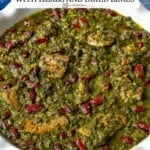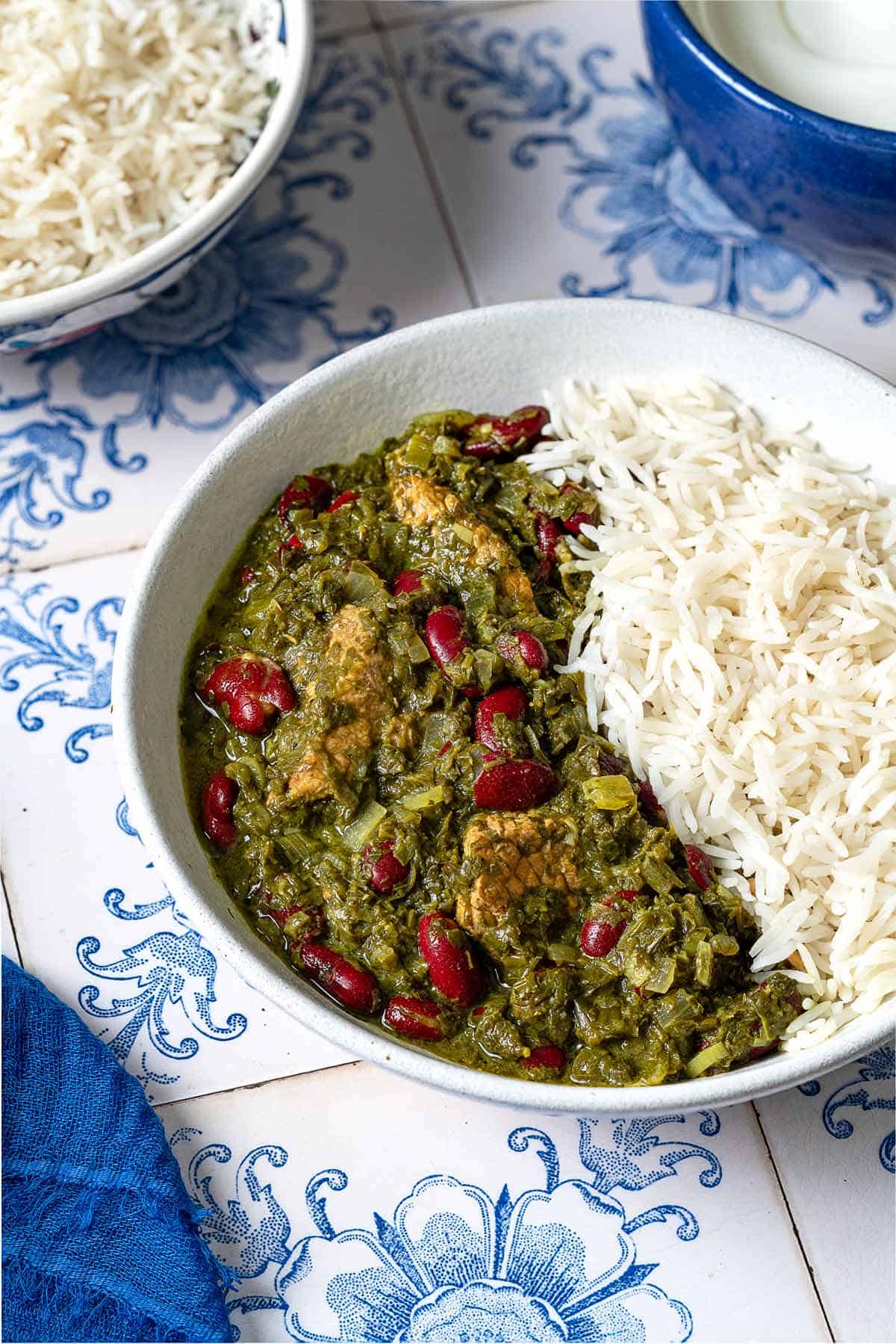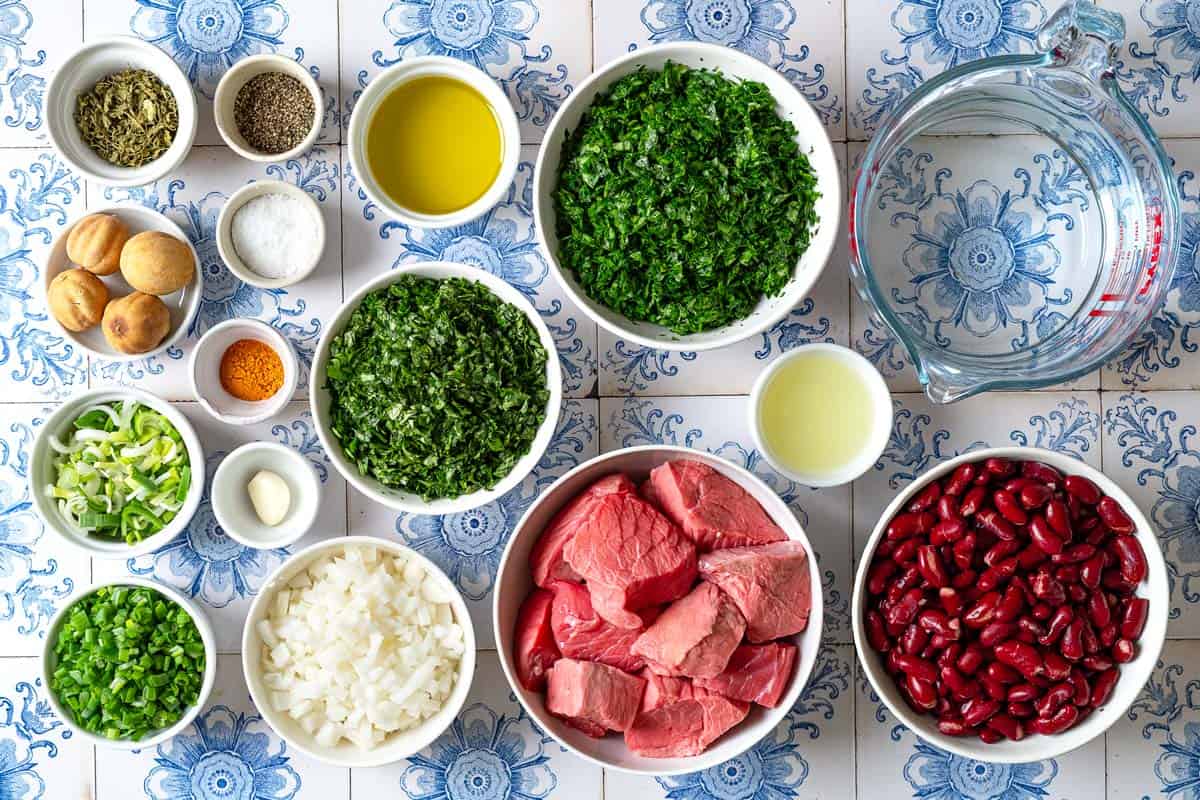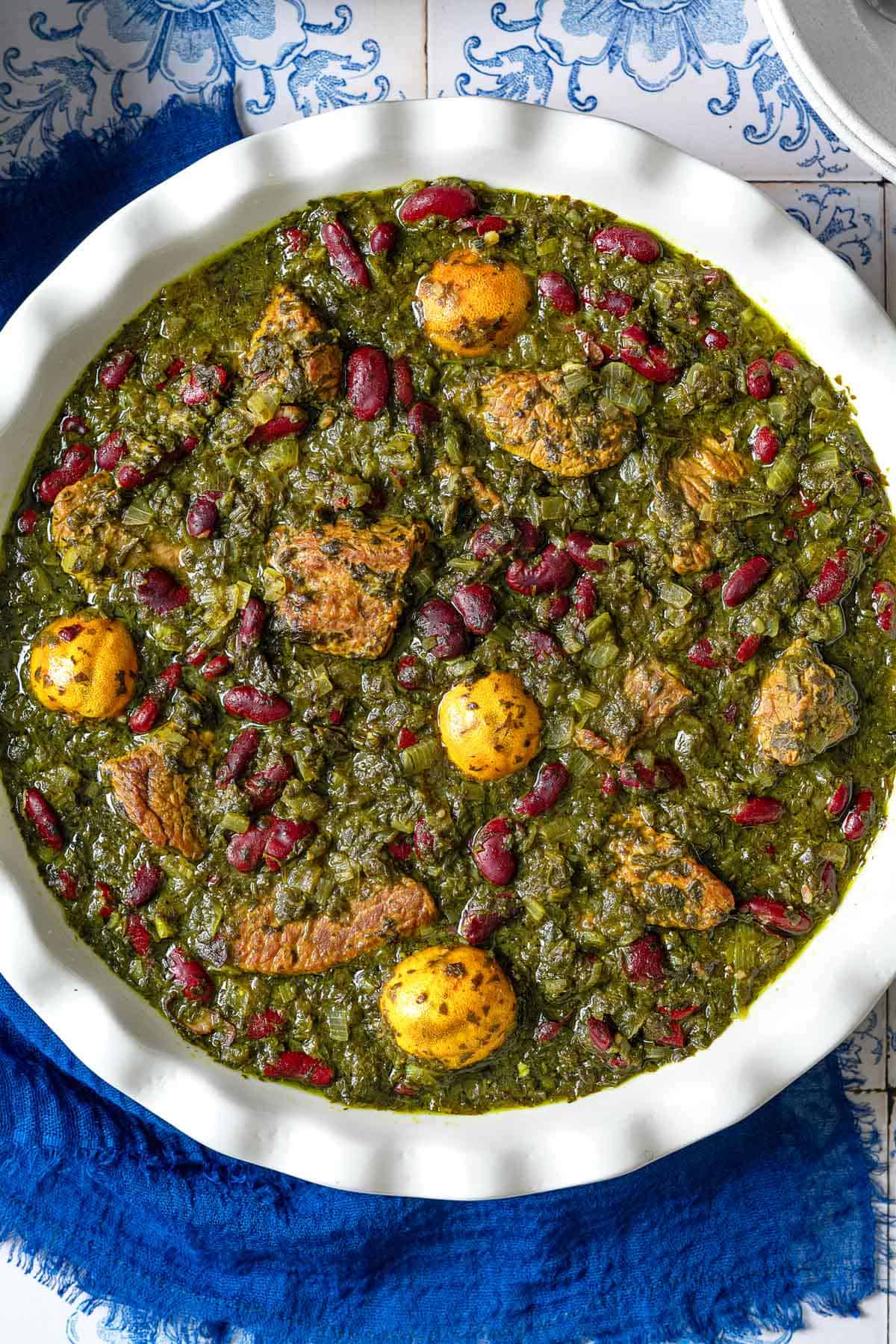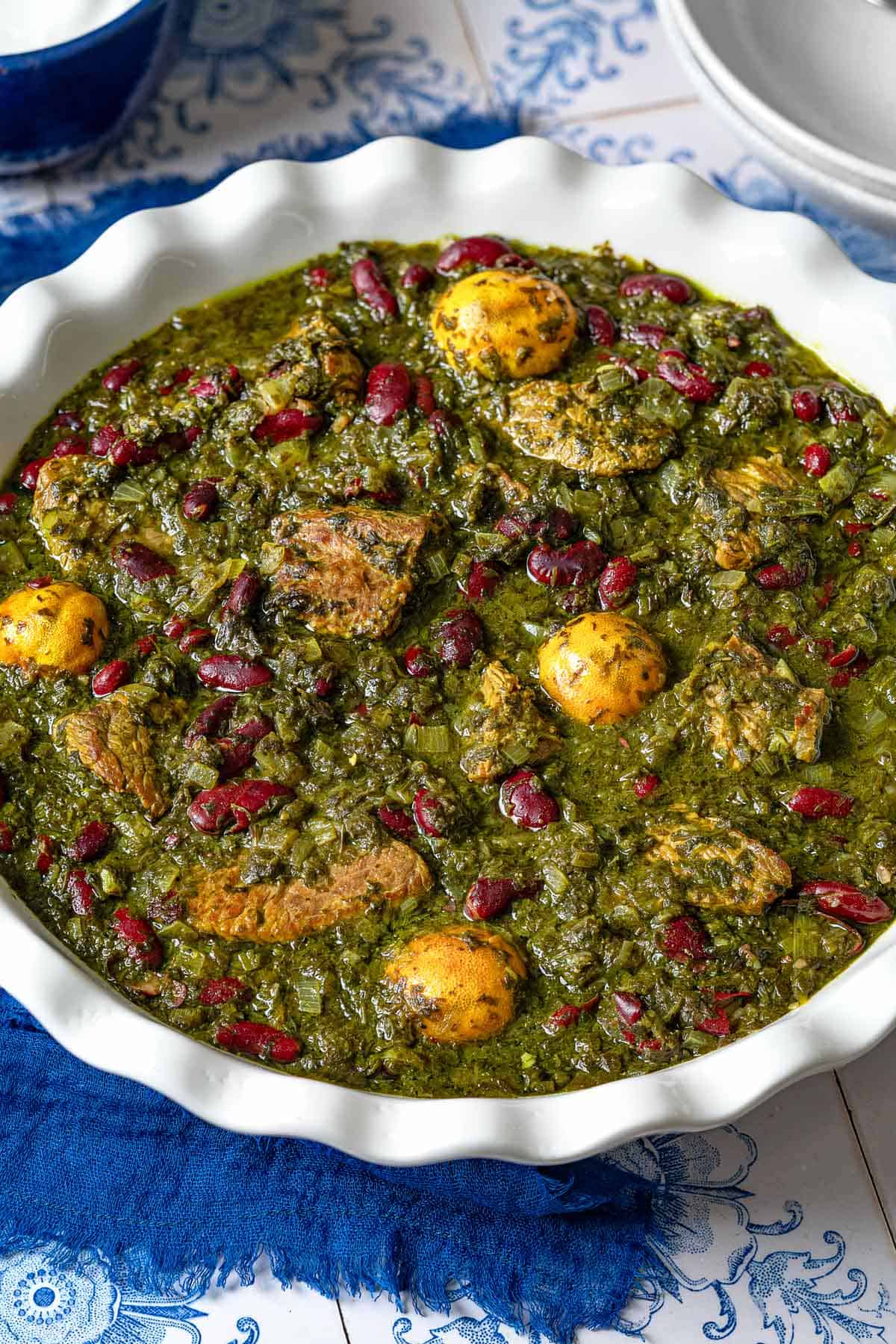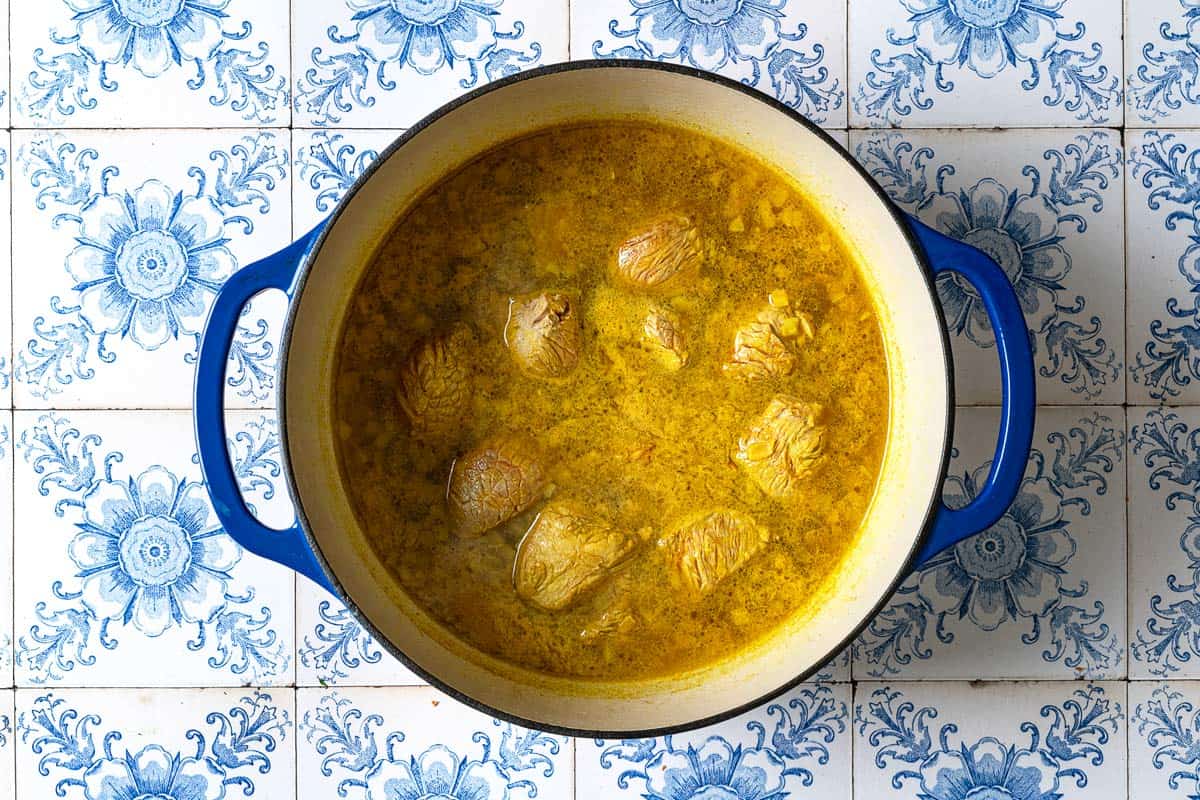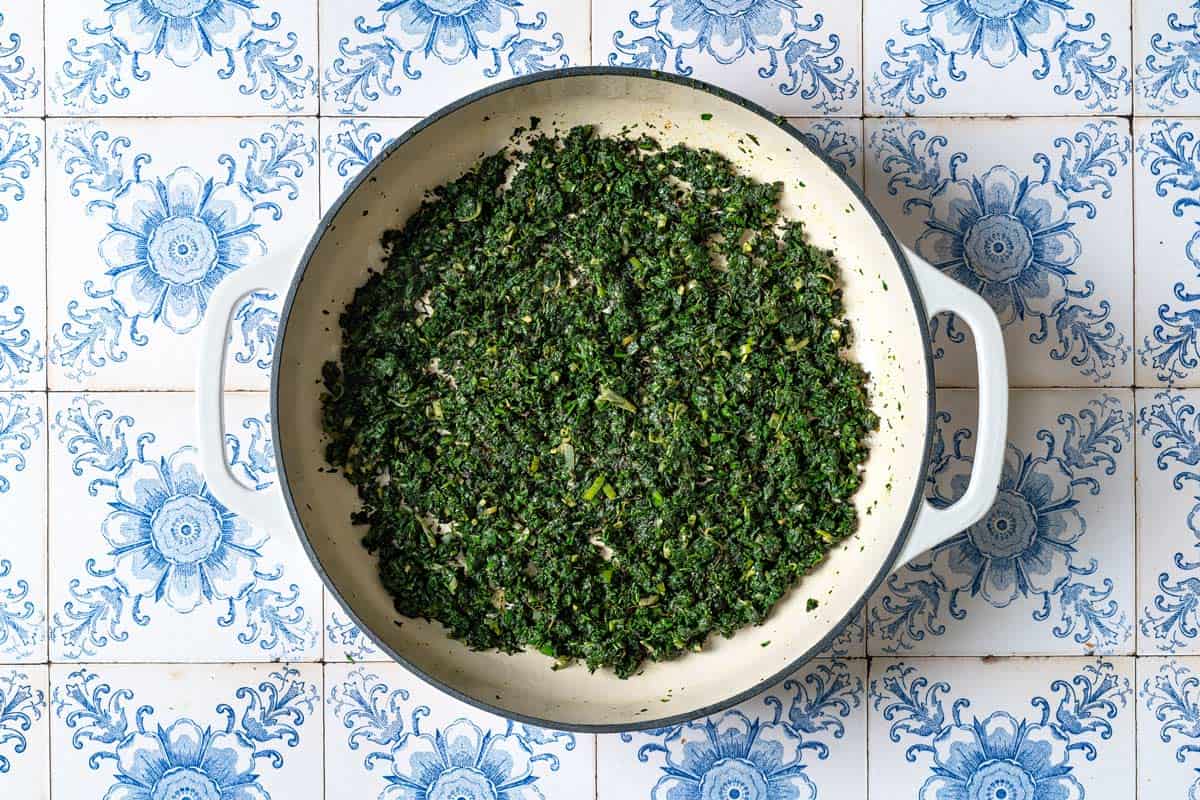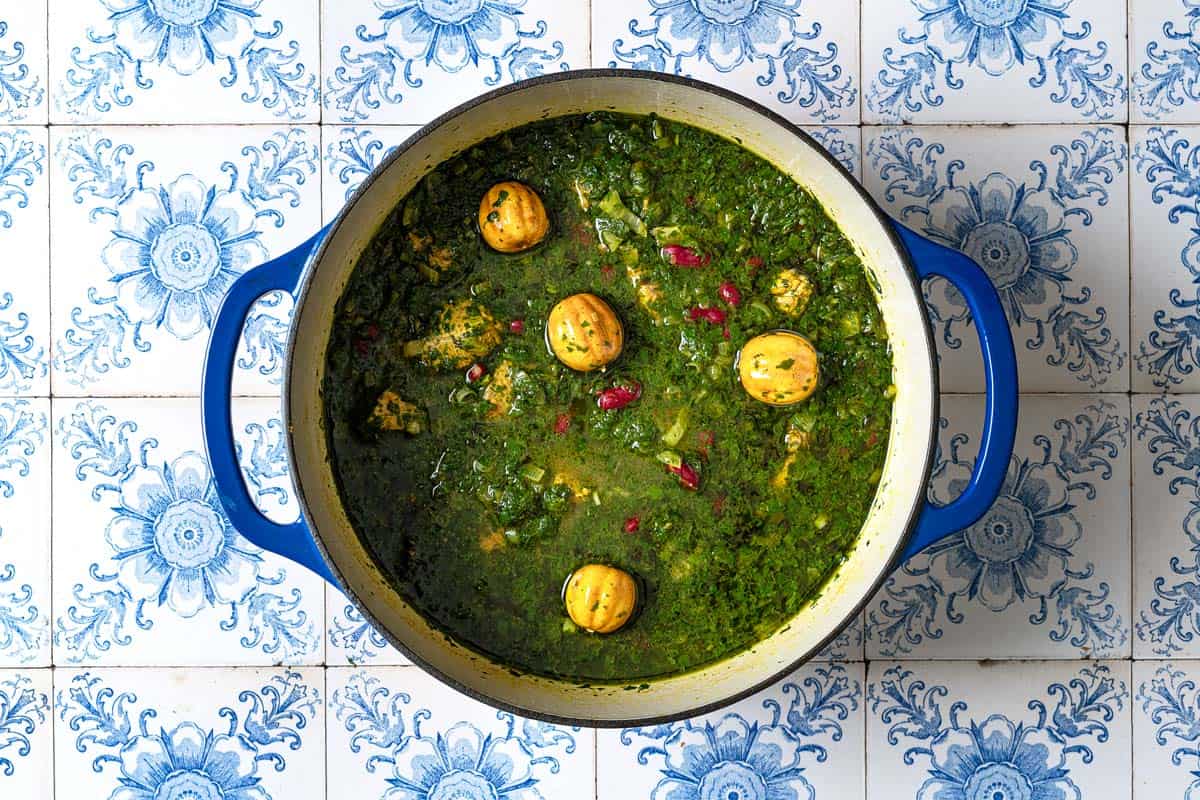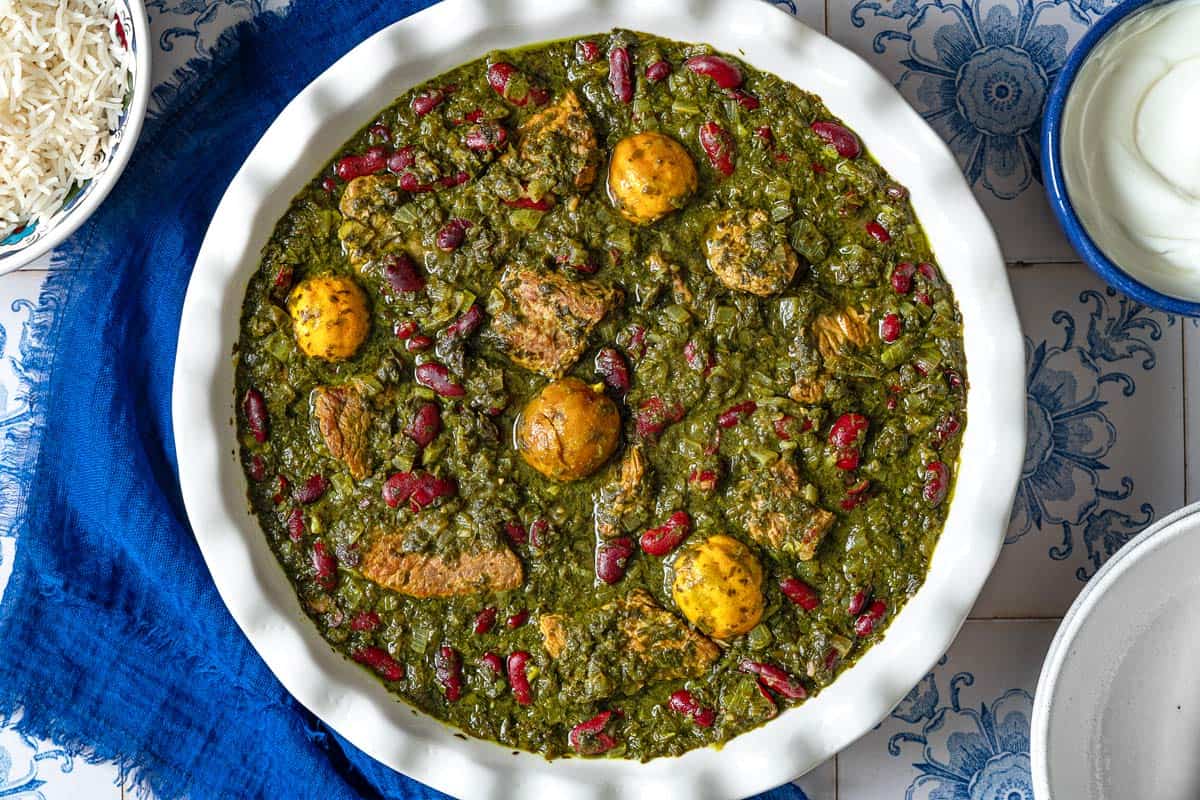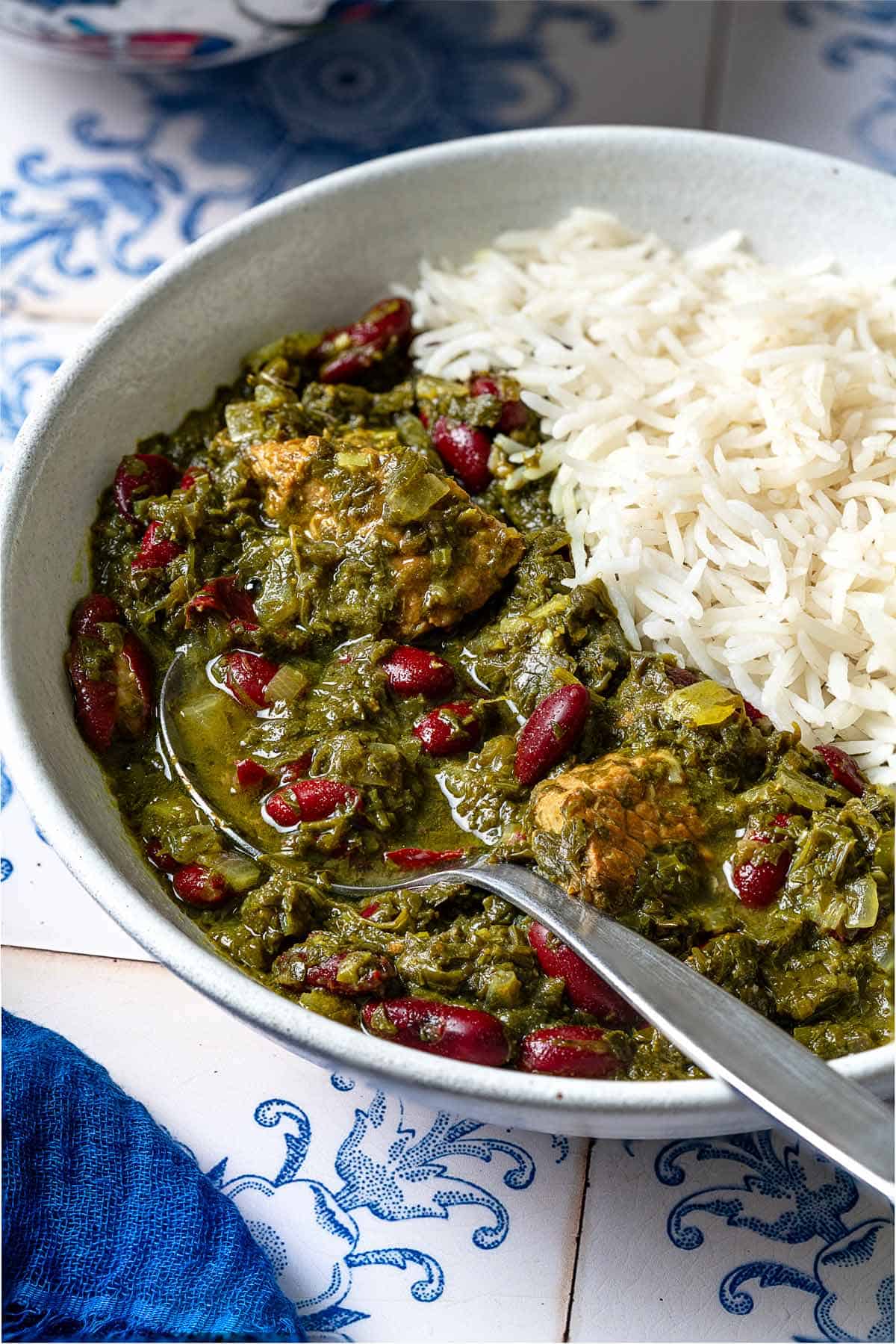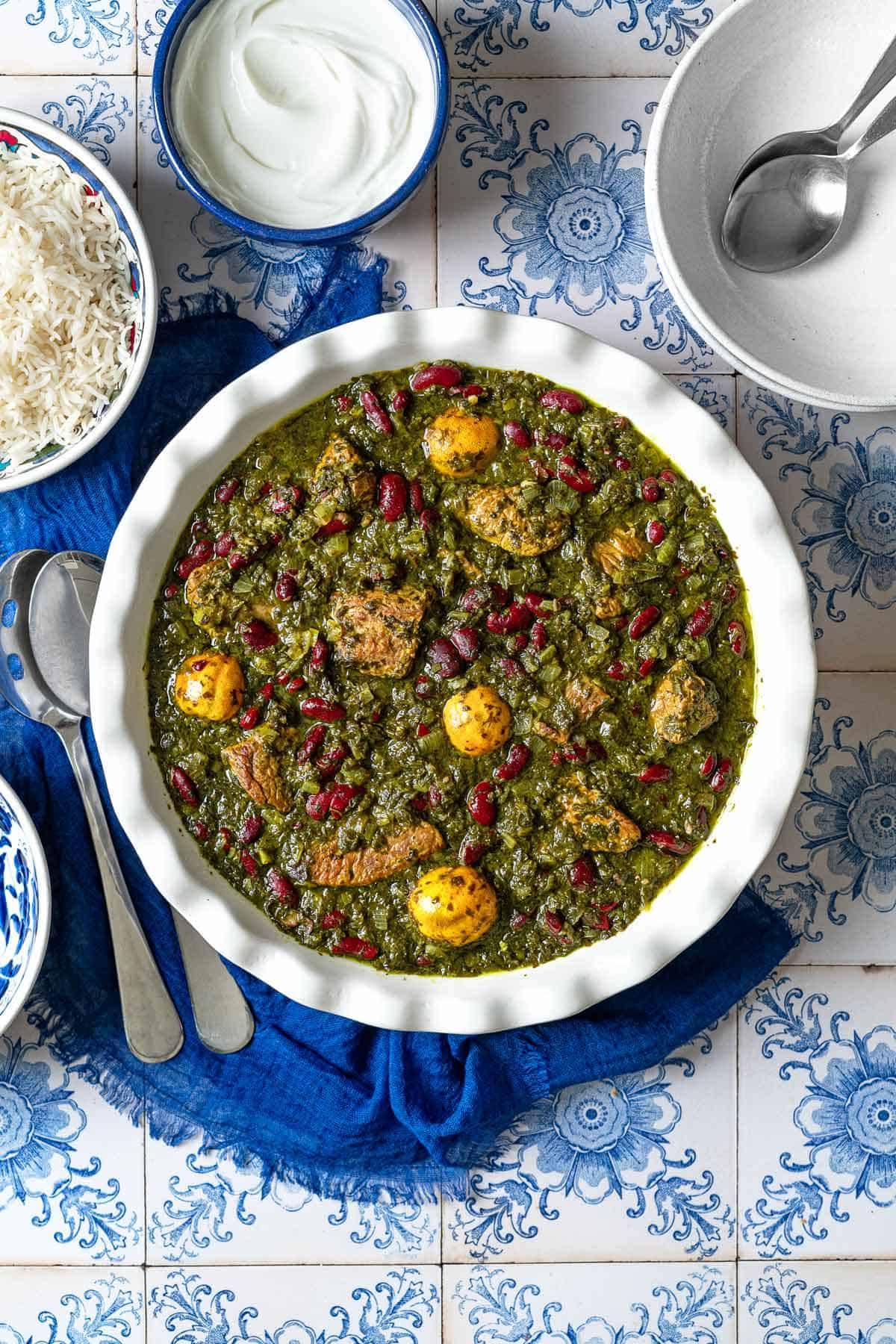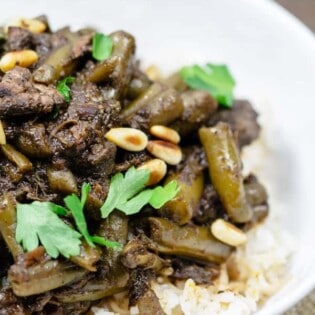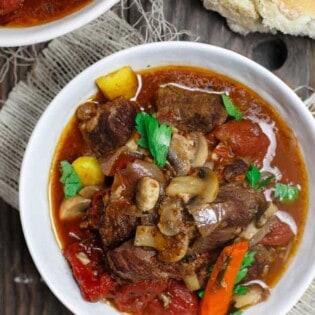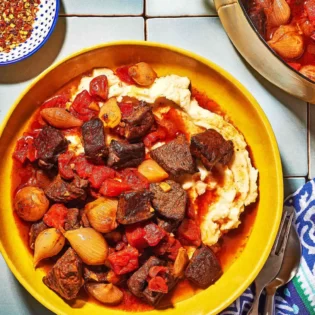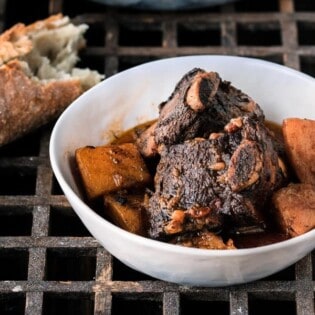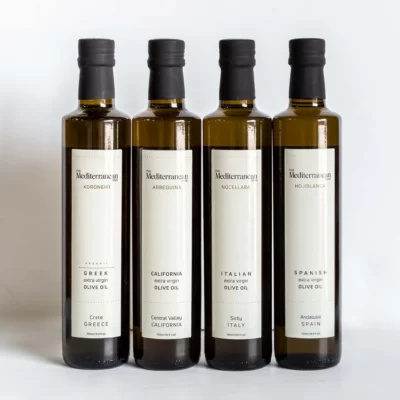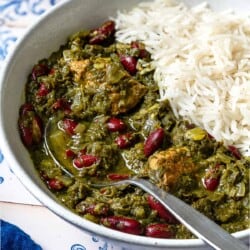There is little debate that Ghormeh Sabzi is the King of Persian stews, with the Queen being Fesenjan (Persian Pomegranate and Walnut Chicken Stew). And if I had to name the one thing that makes this dish so special, it would be the incredible depth of flavor. The combination of herbs like fenugreek, cilantro and parsley with dried limes make for an intensely savory and sour stew, with a comforting richness from the beef and kidney beans. The unique flavor of this traditional beef stew comes from the cooking technique, in which chopped herbs are fried to develop a deep, complex flavor. The stew becomes both darker and more intense the longer you cook the herbs. That’s why you see different shades of Ghormeh Sabzi: Some are more vibrant green while others are so dark they almost look black. This Ghormeh Sabzi recipe leans towards the green end of the spectrum. I like to cook the herbs until they are dark green but not black, as darker versions can sometimes be bitter. Cooking the herbs until they are dark green intensifies the flavors, but maintains the bright flavors from using fresh herbs. Some use the adjective ‘pungent’ to describe this dish, but the modern-day negative connotations do Ghormeh Sabzi a disservice. The flavors may be intense, but they fill the person eating it with joy. Seeing someone’s face the first time they eat Ghormeh Sabzi is utterly brilliant. Pure unbridled happiness and astonishment about a marriage of flavors that are completely new to their taste buds!
What is in Ghormeh Sabzi?
The majority of the ingredients for this Ghormeh Sabzi recipe are readily available at your local supermarket. The exception is dried limes and fenugreek leaves, which you can source online or at your local Middle Eastern or East Asian food shops.
Extra virgin olive oil: Use good quality extra virgin olive oil to cook the onions, beef, and herbs. Onions, leek, and garlic: Crucial aromatics for the complex layers of flavors to this stew. Ground turmeric: A fundamental spice for Persian cooking to flavor the meat in the stew. Beef: Try and get your hands on good quality stew beef, which will assist in making this stew full of flavor. Red kidney beans: Traditionally this stew is made using dried kidney beans, but I use canned kidney beans to save time. Fresh limes: The juice adds extra tartness. Parsley and cilantro: The fresh herbs used for the stew. Dried fenugreek leaves: A herb traditionally and frequently used in South Asian cuisine. It has a very strong earthy aroma and gives the stew its distinctive smell and taste. You can find the leaves at South Asian markets or online. I wouldn’t substitute with seeds, as the leaves have a fresh, herbal taste, while fenugreek seeds are more pungent and bitter. Scallions: In Iran, Ghormeh Sabzi is made with chives. In the UK and US the variety of chives are milder, so we substitute with the green ends of scallions. Dried limes: Add complex musky, tart flavor. Salt and pepper: Seasoning for the stew.
What are Dried Limes and Where to Find Them?
Otherwise known as Limoo Amani, dried limes are limes that have been brined and then dried in the sun. Originating in Oman–hence the Persian name Limoo (lime) Amani (Oman)–they are pricked and then added whole to let their musky flavor and tartness permeate through. Dried limes come in both brown and black varieties. You can use either. Some Iranians boldly eat them along with the stew, but be warned they are bitter and it is completely fine to leave behind. Most people just gently squeeze them to release more tartness, making sure not to break them as their bitter seeds will fall out. You can find dried limes at Middle Eastern Markets, select specialty grocery stores or online. They have a distinct flavor that makes this stew unique. I wouldn’t try to substitute with another spice. But if you don’t like dried limes or can’t find them just stick with the fresh lime juice.
How to Make this Ghormeh Sabzi Recipe
Some argue Ghormeh Sabzi is our national dish–but there is some question on whether that accolade goes to our Kabab Koobideh (lamb kofte kebabs). But debate aside, if you ask a Persian what their favorite dish is, I guarantee you they will either name Ghormeh Sabzi or it will be in their top three. Here’s how you make it:
Cook the Aromatics
Cook the onion: Place a large stock pot on a medium-high heat. Add 2 tablespoons olive oil, follow with finely diced onion, and cook until it turns golden. Add a clove of crushed garlic (optional). Cook the beef: Add 1 1/2 pounds of cubed beef to the pan and stir until browned. Add 1 teaspoon ground turmeric and stir. Then add three cups of water to cover the meat. Bring to a boil, then lower heat to simmer and cover with a lid while you prepare the herbs. Fry the herbs: Place a large frying pan over medium-high heat, add 1/4 cup of olive oil. Follow with a finely chopped leek. Once the leek has softened, add the finely chopped herbs (1 pound parsley, 1/2 pound cilantro, 2 tablespoons crumbled dried fenugreek, and the green parts of 5 scallions). Saute for 5 minutes, stirring frequently. Stew the herbs: Once the herbs have wilted and started to reduce in volume, reduce the heat to medium-low. Continue to stir for 15 minutes further. You are drying out the herbs to intensify their flavor. They will be a dark green color when they are ready. Remove from the heat and set aside.
Simmer and Serve
Simmer. To the pot with the meat, add the fried herbs, 2 cans of kidney beans (drained and rinsed) and 4 dried limes (poked several times with a knife). Add two cups of water. Stir and increase the heat to bring the stew to a simmer. Then lower the heat to cook further for a minimum of 1 hour and 30 minutes. Season the stew: Add salt, pepper, and lime juice to taste. Adjust the stew with water if required, the stew should be thick with herbs but with some broth for your rice to soak up. Serve the Ghormeh Sabzi: Ladle the stew into a serving dish and serve, perhaps with Persian Rice and Salad Shirazi.
Tips for Cooking Ghormeh Sabzi
Growing up, my mother would throw a sheet on the floor and pile up bunches of herbs on top. My sister and I would help her painstakingly remove all the individual leaves. Then she would, batch by batch, finely chop the leaves with a sharp knife. Thankfully now that I am a mother of two daughters I have discovered the joy of a rather excellent food processor. Just remove all the tough woody ends off the parsley and cilantro and pulse until finely chopped. If you chop the herbs too finely they will become bitter, so pulse and work in batches to ensure the right consistency. If you don’t have a food processor, an old-fashioned chop with a sharp knife is the way to go! The longer you leave a Persian stew the better. There is no harm letting it gently stew for a few extra hours, periodically checking to make sure it doesn’t dry out. Alternatively, cook this Ghormeh Sabzi recipe the day before you want to serve it to let the flavors get to know each other and intensify further.
What to Serve with Ghormeh Sabzi
Serve this stew with Persian Rice with Potato Tahdig and a simple chopped salad of tomatoes, cucumbers and tomatoes dressed with lime juice and olive oil like Simple Shirazi Salad. A side of Greek yogurt also complements this dish.
Variations
Traditionally Iranians make Ghormeh Sabzi with cuts of lamb shoulder or lamb leg on the bone. If you prefer lamb and can get your hands on a good quality cut then feel free to substitute the beef. Just increase the amount of lamb to take into account the weight of the bones, approximately 2 to 2 1/2 pounds will be sufficient for the recipe below.
Storage
Keep any leftovers in an airtight container in the fridge for up to 3 days. You can also freeze Ghormeh Sabzi for up to 3 months. Always completely cool down any cooked food before storing in the fridge or freezer. To reheat, place in a saucepan over a low heat or microwave until piping hot. Browse all Mediterranean recipes.
Middle Eastern Beef Stew Recipe with Green Beans
Simple Crock Pot Italian Beef Stew
Stifado (Greek Beef Stew)
Sage-Wine Braised Beef Short Ribs and Potatoes
Visit Our Shop Four of our best-selling signature olive oils, perfect for everyday use.
